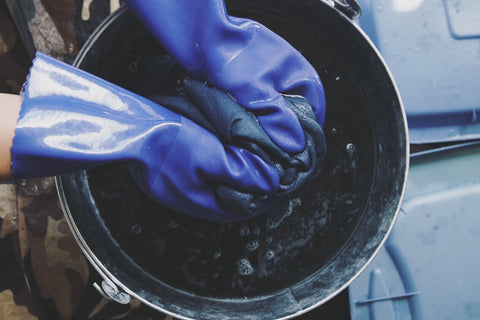Photo by Devan Francis
Did you know that conventional fabric dye contributes up to 17-20% of industrial water pollution? Much of it is left unfiltered, therefore polluting the water we drink and bathe in. That same water is what ends up being used to grow, and sustain our food system, too. It has been found that contaminated water sources, especially those in close proximity to leather tanneries, for example, has been directly linked to birth defects and terminal illnesses of the people inhabiting the area. This waste water then goes into our oceans, killing off whole species of marine life essential to our ecosystems; choking our very existence. If you’re left wondering how we as a society have come this far, and what we can do to lessen our impact, then you may want to consider switching to naturally-dyed conscious clothing! Kaya has explained her process of naturally dyeing pieces at Novel Supply Co and Abel Wear, and how you can do it yourself if you so desire!
In the beginning, Kaya remembers that upon searching for bulk amounts of non-toxic fabric, she found that it just simply didn’t exist! She then took matters into her own hands and began experimenting with natural Indigo, or Indigofera Tinctoria, a plant that has been used for over 4000 years and is the most ancient and successful dye plant to date. To achieve the indigo colour in powder form, it is picked in the field, soaked in water to release the natural glucose inside, then dried in the sun and continually flipped until the leaves become purple-blue, mashed, pressed, and finally ground. The end result once dyed onto clothing can yield a wide range of colours and is also naturally antibacterial. In fact, it was so effective that it was used under Japanese samurai armour to prevent bacteria growth, offered protection against wounds, and was even found to be fire-retardant. (Makes your denim seem a bit more bad-a**, doesn’t it?) Wear it forever, and benefit from the amazing qualities of indigo indefinitely. That's what we call sustainable fashion! Now, to bring it back to the Pacific Northwest:
P R O C 3 S S :
Here are the ingredients Kaya uses for a large 15-19 gallon vat:
60 g | 1/4 cup natural indigo
120 g | 1/2 cup lime (calx)
180 g | 3/4 cup fructose
NOTE: This is double the Maiwa recipe but it results in a medium blue after two dips.
To turn the powdered indigo into liquid dye as a condensed starter solution, Kaya uses the 1-2-3 method. This is achieved by first hydrating one part indigo with warm water. Kaya, gets her indigo from Maiwa which is a very fine powder and does not need to be hydrated (shaken with water and marbles). If your indigo is not as fine, you may want to shake it with water and marbles in a plastic container to get the most out of the dye. Meanwhile, in a separate container, fructose is combined with warm water, then added to the mixture. The purpose of adding fructose to the indigo is to begin drawing oxygen out of the solution. From there, half the calcium hydroxide, also known as slaked lime, is mixed with warm water and added in (the other half will be added into the vat the next day). Then the solution is stirred with a stick. This careful pre-process is used to make the dye more vibrant and effective than if everything were to be added to the vat at the same time.
This starter solution is left to ‘brew’ overnight. The next day, it is added (along with the additional calcium hydroxide) into a 15-19 gallon vat of water and heated to 120° F. There will be a layer resting on top once the solution has reached the right temperature, called the ‘flower’. This is moved to the side and then pre-wetted garments are gently added one by one so as to avoid adding oxygen. If oxygen is introduced (this happens by quickly adding garments in and out), the indigo will become neutralized and will not produce the desired effect. One vat will usually produce 25 dyed garments if dipped twice for about 15 minutes in a 60g batch of indigo. Kaya usually lets the garments air dry overnight after doing an initial rinse, then washes them in the morning to let the dye set in more. To get darker hues, continue to dip your garments until they are two shades darker than desired.
Photo by Kaya Dorey
To finish off the process, quickly whisk (adds oxygen to) your leftover dye solution with vinegar or lime (acid) to neutralize the dye solution (alkaline) and add extra water before dumping it down the drain. If you prefer to give the mixture a second life, both the liquid and sediment from this process can be used as compost. Since there are still some negative effects of dumping even natural indigo down the drain, it can also be used as a weed-killer, but exercise caution on plants you intend to grow. Alternatively, you could get really creative by reducing the solution in a pot into an ink, which could be used as paint, or perhaps to write letters! Lastly, don’t forget to wear a face mask! Like any powder, it can be harmful to humans to inhale large amounts of tiny foreign particles. Happy dyeing!




Leave a comment